78. Song #3 “Welcome Sweet and Sacred Feast”

Song #3 “Welcome Sweet and Sacred Feast” Gerald Finzi [8:34]
The Finzi Singers, Harry Bicket, Organ, Paul Spicer, Director
Gerald Finzi (1901-1956) wrote this extraordinary anthem in 1953. Certainly speaks to us in this time of distress poignantly.
The text is from “The Holy Communion” by the Welsh metaphysical poet Henry Vaughan (1622-1695). Follow along the poet’s words below.
Welcome sweet, and sacred feast; welcome life! Dead I was, and deep in trouble; But grace, and blessings came with thee so rife, That they have quicken’d even drie stubble; Thus souls their bodies animate, And thus, at first, when things were rude, Dark, void, and Crude They, by thy Word, their beauty had, and date; All were by thee, And still must be, Nothing that is, or lives, But hath his Quickenings, and reprieves As thy hand opens, or shuts; Healings, and Cuts, Darkness, and day-light, life, and death Are but mere leaves turn’d by thy breath Spirits without thee die, And blackness sits On the divinest wits, As on the Sun Eclipses lie. But that great darkness at thy death When the veil broke with thy last breath, Did make us see The way to thee; And now by these sure, sacred ties, After thy blood (Our sov’rain good,) Had clear’d our eyes, And given us sight; Thou dost unto thy self betroth Our souls, and bodies both In everlasting light. Wasn’t not enough that thou hadst pay’d the price And given us eyes When we had none, but thou must also take Us by the hand And keep us still awake, When we would sleep, Or from thee creep, Who without thee cannot stand? Wasn’t not enough to lose thy breath And blood by an accursed death, But thou must also leave To us that did bereave Thee of them both, these seals the means That should both cleanse And keep us so, Who wrought thy wo? O rose of Sharon! O the Lilly Of the valley! How art thou now, thy flock to keep, Become both food, and Shepheard to thy sheep.
Selection source: 78. Song #3 “Welcome Sweet and Sacred Feast”
77. Sing Gently

“Sing Gently” Eric Whitacre [3:20, 10:32 with credits]
Virtual Choir 6
17,572 singers united in one splendid musical virtual choir. If nothing else the technical wizardry of such a video is astonishing. This is one of several Whitacre virtual choir offerings in my playlist (do look for them below in the complete list). What better way to celebrate the e pluribus unum concept so needed in our time of distress.
Selection source: 77. Sing Gently
76. Toccata in G Minor BWV 915
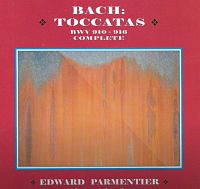
Toccata in G Minor BWV 915, Johann Sebastian Bach [8:49]Edward Parmentier, Harpsichord Bach composed seven solo harpsichord works (BWV 910-916) entitled “toccata” likely written between 1707 and 1717 during his employment as court musician for the Duke of Weimar. The twenty-something-year old Bach had become a force to be reckoned with and these toccatas are evidence of his precocious brilliance and vigor. Toccata is an Italian term derived from the verb “toccare” meaning “to touch.” It is music that evolves from the hands and fingers sensual exploration of the keyboard. Toccatas originated in 17th century Italy and France with improvisatory whimsy rather than rigid craft. But with Bach craft and structure mirror a mind so ingenious that even improvisatory music turns into a sonic tour de force. The G minor Toccata begins with a grand gesture—a flourish followed by the slow improvisatory “touching.” From here Bach alternates moods from vivacious joy to pensive hovering. A grand double fugue echoes the joy like a jig theme first heard right side up then later upside down (inverted). The piece ends as it began with a wild flourish, as if to say, OK ta ta, that’s enough. This truly is music to lift the soul, heart, and mind! ~ J.A.Y. P.S. Bach-Werke-Verzeichnis = BWV or cataloged index of his music
Selection source: 76. Toccata in G Minor BWV 915
75. Pancham Se Gara

Pancham Se Gara Ravi Shankar [11:27]
Anoushka Shankar—Sitar, Tanmoy Bose—Tabla, Kenji—Tampura
Indian music is very mathematical even geometric in its substance. The title says “Five of Gara” and Gara is a raga or musical scale. In some ways the classical Indian raga is less a scale than a structure that evolves during the playing. But understanding it is less important than just listening to it. The beauty of the tones, the timbres, the rhythms, not unlike the kaleidoscopic micro changes in Philip Glass (see #17) minimalism, flood over us without and need of thought. Anoushka is the daughter of Ravi Shankar who wowed George Harrison and Yehudi Menuhin thus bringing the non-Indian world to this Hindustani classical music.
Selection source: 75. Pancham Se Gara
74. Variations on a Theme of Frank Bridge Op. 10
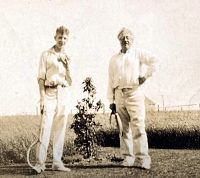
Variations on a Theme of Frank Bridge Op. 10 Benjamin Britten
[25:49]
English Chamber Orchestra, Steuart Bedford—Conductor
Benjamin Britten (1913-1976) stands as one of England’s greatest composers. Certainly he is equal to the greatness of Ralph Vaughan Williams, Edward Elgar, Gustav Holst and others. This set of variations on a theme by his beloved composition and theory teacher, Frank Bridge (1879-1941), is a masterpiece of string writing. Each variation is a gem. I hope you persevere and listen all the way through. Britten touches every emotion, from pratfall humor (Var. 6 Wiener Walzer) to profound pathos (Var. 8 Funeral March). He stretches the tonalities of string orchestra instruments to their limits, exploring a huge expressive range. At times he even makes the orchestra sound like a ethereal human voice (Var. 9 Chant). This is my desert island music!
Selection source: 74. Variations on a Theme of Frank Bridge Op. 10
73. Indonesian Gamelan Medley from Java, Sunda and Bali

Indonesian Gamelan Medley from Java, Sunda and Bali [12:33]
Amadinda Percussion Group, Triginta Percussion, Péter Szalai and László Tömösközi
This traditional and indigenous music of the Javanese, Sundanese and Balinese people is called Gamelan. Primary instrumentation are metallophones and hand drums. The word gamelan refers to the mallet used to strike the instruments. The art form of a pre-Hindo-Buddhist culture possibly dating back to AD 230. Interestingly, I find this music may have elements (intrinsically) in common with the minimalism (see #17, Glass) in the repetition and rhythmic progressions. Exotic as this music may be to American ears, it is a delight for its sensations of sonority. Here is the breakdown of the four types.
Central Java ( Javanese ) 00:00 - 02:53
Java ( Sundanese) 02:53 - 05:51
Bali ( Balinese ) 05:51 - 11:18
East Java ( Javanese ) 11:18 - 12:25
Selection source: 73. Indonesian Gamelan Medley from Java, Sunda and Bali
72. Dead White Man Music, 2. Flow (My Tears)
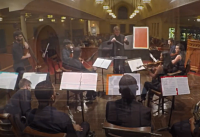
Dead White Man Music, 2. Flow (My Tears) Evan Williams [6:56]
Daniel Walden—Harpsichord, Urban Playground Chamber Orchestra, Thomas Cunningham—Conductor
Composer Evan Williams, who grew up in Chicago, began his musical journey in middle school with trombone leading eventually to a passionate interest in composition. With multiple degrees in music culminating in a Doctor of Musical Arts (DMA) in composition from Cincinnati Conservatory of Music, he now teaches at Rhodes College. Recently, he collaborated with the Urban Playground Chamber Orchestra (New York City) commissioned to write several extraordinary compositions. Reflecting about the predominance of the Classical canon, the music of long-deceased white male Europeans, he writes, “Dead White Man Music serves as a personal reflection on this issue, and my own place in classical music as a young black composer.” He continues “This concerto for harpsichord draws inspiration and influences across the centuries: from Bach and Dowland to Julius Eastman and Nina Simone, and from the Baroque to Post-Minimalism and Rock. Through the work I ask: what music am I called to write and who should be my models?” Like Heitor Villa-Lobos (see #71) Williams successfully uplifts beauty by tapping diverse cultural origins.
Selection source: 72. Dead White Man Music, 2. Flow (My Tears)
71. Bachianias Brasileiras No. 5
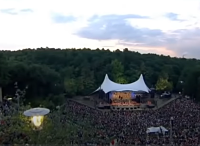
Bachianias Brasileiras No. 5 Heitor Villa-Lobos [12:50]
Ana Maria Martínez—Soprano, Orquestra Filarmônica de Berlim. Gustavo Dudanel—Conductor
Brazilian composer Heitor Villa-Lobos (1897-1959) composed nine extended works that celebrate the composer’s love of both Bach and native Brazilian music with a marriage of the two styles. No. 5 is the most famous of the nine suites distinctively written for eight cellos and soprano. With two movements, sung in Portuguese, the first “Aria” begins wordlessly leading to the sensuous almost mystical poem:
In the evening, a dreamy, pretty cloud, slow and transparent, covers outer space with pink. In the infinite the moon rises sweetly, beautifying the evening, like a friendly girl who prepares herself and dreamily makes the evening beautiful. A soul anxious to be pretty shouts to the sky, the land, all of Nature. The birds silence themselves to her complaints, and the sea reflects all of Her [the moon’s] wealth. The gentle light of the moon now awakens the cruel saudade [nostalgic or melancholic longing] that laughs and cries. In the evening, a dreamy, pretty cloud, slow and transparent, covers outer space with pink. The second movement “Dança” enumerates the birds of the Cariri Mountains. That a crowd of thousands sits spellbound in silent attention with such beauty in the open air testifies of the power of this music and its composer.
Selection source: 71. Bachianias Brasileiras No. 5
70. Le Tombeau d’Olivier Messiaen #2. “I Give Thanks To My God”
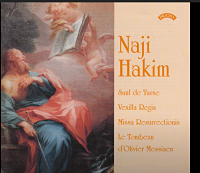
Le Tombeau d’Olivier Messiaen #2. “I Give Thanks To My God”
Naji Hakim [6:37]
Cavaillé-Coll Organ at La Trinité Church, Paris. Naji Hakim—Organist & Composer
While on sabbatical in 1997 from my college I lived in France and had the great privilege to study improvisation with a master teacher, Naji Hakim. Our lessons were at the great organ of the Trinité Church in Paris. Hakim succeeded Olivier Messiaen at La Trinité who was tenured organist from 1931 until his death in 1992 (see #50). Hakim composed this piece as a memorial to Messiaen. We hear the second movement which is both representative of Hakim’s improvisatory style and a fine homage to his predecessor. I quote from his website: The second piece is much slower, gentler, and Hakim asks that it be played ‘with love’. The quotation from St. Paul is once again from the pistle to the Philippians: ‘in all my remembrance of you, always in every prayer of mine for you, making my prayer with joy, thankful for your partnership in the gospel’. There are three sections, all based on a Maronite melody from the Lebanon, Hakim’s birthplace. In the first, the melody is played on the pedals against poignant harmonieson the swell anual, quoting from Messiaen’s earlier piece, ‘Les Offrandes oubliees’. The second, slightly faster section, alternates a melody on the plaintive vox humana stop with softly glowing chords typical of Messiaen’s harmonic style. In the third section, curvaceous phrases of melody in double thirds are accompanied by a repeated cycle of chords articulated in a repeated rhythmic pattern of four notes, short-long-long-short. The music is reflects both Messiaen and Hakim’s reverence for the great organ they shared using many of its exotic stops.
Selection source: 70. Le Tombeau d’Olivier Messiaen #2. “I Give Thanks To My God”
69. Deep Forest “Sweet Lullaby”
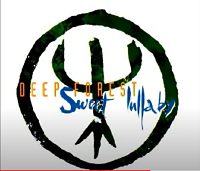
Deep Forest “Sweet Lullaby” Baegu Lullaby Solomon Islands a. [6:13] b. [4:45]
Vocal sample Afunakwa, Synthesis mix by Michel Sanchez and Éric Mouquet
An enthnomusicologist, Hugo Zemp, recorded a woman named Afunakwa, as part of a UNESCO collection in 1971. Her song is about a young orphan being comforted over the loss of his parents. In 1994 two French musicians created their album, Deep Forest, which is a techno musical mix of the ethnic song plus new age electronics. Here are offered the original track (a.) in extended version and a video version (b.) with an astonishing visual tour de force. Listen to music only. Listen with video. Your choice. The music itself is hauntingly beautiful even without the visual stimulation. In some ways this popular style has elements of Philip Glass (#17) with minimalist repetition. The video,
though well done, may not be to everyone’s tastes, yet it gives the lullaby the twist of an child’s odyssey. My suggestion is to be adventurous and listen and watch both.
a. Sweet Lullaby (Extended version) music only. https://www.youtube.com/watch?v=iFS_nfNvD2o&list=RDiFS_nfNvD2o&start_radio=1
b. Sweet Lullaby (Official Video version) https://www.youtube.com/watch?v=lIF5EEneWEU
Selection source: 69. Deep Forest “Sweet Lullaby”
68. Sinfonietta for Orchestra

68. Sinfonietta for Orchestra, Leoš Janáček [25:41]London Symphony Orchestra, Sir Simon Rattle—Conductor
Leoš Janáček [1854-1928] whose birthday was July 3 made his mark as a the most prominent Czech composer since Antonin Dvořák. His music is both nationalistic and modern without losing a universal appeal. The Sinfonietta begins with a wonderful brass fanfare as if to say “pay attention” and over the four movements we find more than enough reason to do so. It is glorious music and the craft and cleverness are on full display. He was also an organist who contributed significantly to the organ repertoire.
Selection source: 68. Sinfonietta for Orchestra
67. Motet: “When David Heard That Absalom Was Slain”
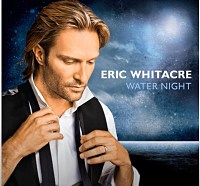
Motet: “When David Heard That Absalom Was Slain” Eric Whitacre
Eric Whitacre Singers Eric Whitacre—Director
Earlier in this playlist (#35) came Eric Whitacre’s spectacular virtual choir singing his “Lux aurumque” an impressive technical feat (the video) as well as stunning musically. Here we have a modern approach to the ancient text from 2 Samuel 18:33 (see # 64, 65 & 66). Like Tomkins and Weelkes, Whitacre deftly portrays the deepest grief but clothed in modern art’s dissonant reality. People sometimes complain about dissonance in modern art (both visual and aural). Yet authentic art must reflect its epoch and time in all its truths. Our world is rife with dissonance and disharmony unlike perhaps any other age. Our world suffers in ways unimaginable before two world wars, terrorism, racism and global pandemic. So our music to be true cannot but voice the uncomfortable. Whitacre’s take on David’s grief expands grief beyond this world’s horizons. Give it more than one listen.
Selection source: 67. Motet: “When David Heard That Absalom Was Slain”
66. Motet: “When David Heard That Absalom Was Slain”

Motet: “When David Heard That Absalom Was Slain” Thomas Weelkes
Choir of St. John’s College, Cambridge George Guest—Director
A contemporary of Tomkins (see #65 & $64) Thomas Weelkes (1576-1623) took a different approach to the scripture by giving the words a stronger rhetorical impact with block harmony (homophony) rather than layered voices (polyphony). The effect on the listener is to declaim the text mostly in one choral (albeit harmonic) voice. Weelkes gives the prophet Samuel’s narrative words clarity and strength to set the stage of David’s lament that follows. David’s words also begin similarly in homophony where all the singers’ words are phrased together. Then as David’s grief wells up “Would God I had died” Weelkes changes to 5 voice polyphony where the phrases layer and overlap giving rise to the full complexity of grief. This old recording (1961) though complete with rumble and sounds of vinyl records is pristine in interpretation under Dr. Guest’s able direction.
Selection source: 66. Motet: “When David Heard That Absalom Was Slain”
65. Motet: “When David Heard That Absalom Was Slain”
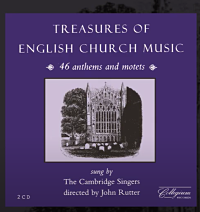
Motet: “When David Heard That Absalom Was Slain” Thomas Tomkins [5:09]
The Cambridge Singers John Rutter—Conductor
Here we have another performance with a mixed choir of the Tomkins motet (see #64). The music is transposed up in a key to accommodate the higher voicing. Splendid and no less beautiful, just different. Note the cleverness of the text painting especially at the end where the words “O Absalom my son” echo and fade into perfect grief.
Selection source: 65. Motet: “When David Heard That Absalom Was Slain”
64. Motet: “When David Heard That Absalom Was Slain”
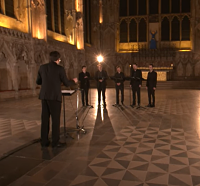
Motet: “When David Heard That Absalom Was Slain” Thomas Tomkins [4:55]
The Gesualdo Six at Ely Cathedral
King David’s lament from 2 Samuel 18:33 is a favorite text for choral composers from the Renaissance to this day. Thomas Tomkins (1572-1656) lived through the tumultuous reigns of Elizabeth I, James I, and Charles I dying at age 84. His music is marked by expressive text painting. He oversaw the construction of a huge organ in Worcester Cathedral, only to witness sadly its ruin as a casualty of civil war and its iconoclasm. His madrigals, anthems and motets mark an output perhaps more prolific than any other composer in 17th century England.
Selection source: 64. Motet: “When David Heard That Absalom Was Slain”
63. Rhapsody in Blue
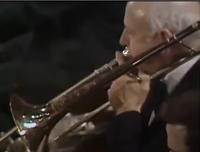
Rhapsody in Blue, George Gershwin [17:02]
New York Philharmonic (at Royal Albert Hall 1976) Leonard
Bernstein—Pianist/Conductor
Two giants of American music make this recording a must listen! George Gershwin (1898-1937) is our national musical treasure who recounted that he wrote this piece (mentally) while traveling by train inspired by the rhythmic pulses and soundscape of the rails. He was 26 when he wrote it. Bernstein was 58 when he played this flawlessly from memory. Here exists a perfect synthesis of symphonic music and jazz into our national ethos—Americana.
Selection source: 63. Rhapsody in Blue
62. Cantata 8 Chorus 1 “Liebster Gott, wenn werd ich sterben”
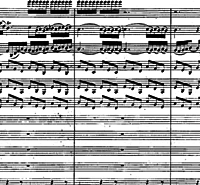
62. Cantata 8 Chorus 1 “Liebster Gott, wenn werd ich sterben” Johann Sebastian Bach [5:49]
King’s College Choir Cambridge, Leonhard-Consort, Gustav Leonhardt—Conductor
Previously (61) we heard an aria from this amazing cantata. Here Bach depicts existential concepts—time, life and death. The chorus asks “Dear God, when will I die?” and the music in lilting rhythms begins a funeral procession. In Bach’s day, a bell was rung 24 times to mark death and time, perhaps the hours of a day. The flute chirps 24 times over and over again. The effect is actually soothing and almost cheerful. Remember that in the bass aria we heard the answer to this profound question is implied. It doesn’t matter, because we will stand and share the light eternal of Christ.
Selection source: 62. Cantata 8 Chorus 1 “Liebster Gott, wenn werd ich sterben”
61. Cantata 8 Bass Aria “Doch weichet ihr tollen”
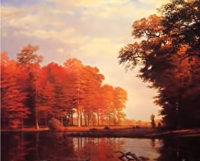
61. Cantata 8 Bass Aria “Doch weichet ihr tollen” Johann Sebastian Bach [5:51]
Dietrich Fischer-Dieskau—Baritone, Berlin Philharmonic Orchestra, Karl Forster—Conductor
Bach (1685-1750) probably composed about 400 cantatas (only 225 survived). Most cantatas last about 20 minutes and involve soloists, chorus, and small orchestra. It is an astounding body of music by any measure. Cantatas served to enlighten and unpack theological ideas or religious themes each Sunday during the Lutheran worship which lasted about three hours. They were like sermons in music. Cantata 8 was probably written in 1724 for the sixteenth Sunday after Trinity. This aria with its lilting and joyous flute against the robust baritone sings about a happy afterlife. In death we stand with Jesus sharing in his glorious transfigured light. (see the words under SHOW MORE).
Selection source: 61. Cantata 8 Bass Aria “Doch weichet ihr tollen”
60. Obra de Primo Tono Bajo

60. Obra de Primo Tono Bajo José de Torres y Martinez Bravo [5:07]
Organ of the Cathedral Mexico City (1735) Gustavo Delgado Parra, Organist
José de Torres y Martinez Bravo (1670-1738) was born in Madrid. His compositions include large choral works with instruments and organ such as cantatas, masses, and canticles. A large collection of his manuscripts resides in Guatamala’s cathedral. His organ music exemplifies the Spanish baroque with great complexity and a bravura technique. Spanish organs have a distinctive sound dominated by trumpet like stops, often placed horizontally to accentuate their brassy tone. Organs embellished the churches of Mexico (New Spain) both with their bold sound as well as their splendorous facades. This magnificent organ was built in 1736 and restored in 2008. Pipe organs and their music have had a significant place in Central and South America churches large and small for centuries.
Selection source: 60. Obra de Primo Tono Bajo
59. Motet “Christus factus es pro nobis”

59. Motet “Christus factus es pro nobis” Anton Bruckner [5:36]
King’s College Cambridge Choir Sir Stephen Cleobury, Director
Anton Bruckner (1824-1896) wrote this motet in 1884 for Holy Week services. An Austrian composer and organist, Bruckner worked humbly devoting much of his life to music in church. He was a devout Catholic and his music reflects the mysticism of its liturgy at that time. He could be called an ultra-romantic in style, yet his music harks back to the early motets of the renaissance except for their rich chromatic harmonies. If there is one word to describe this music it is sublime. The men and boys of King’s College do it more than justice!
Selection source: 59. Motet “Christus factus es pro nobis”
58. Scherzo No. 2 in C Minor
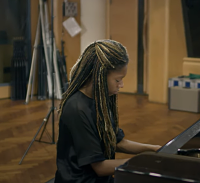
58. Scherzo No. 2 in C Minor, Clara Schumann [4:57]
Isata Kanneh-Mason, Pianist
Clara Schumann (1819-1896) was a child prodigy schooled in Leipzig by her father Frederick Wieck. At eleven she began a career that lasted over 61 years as piano virtuoso touring all of Europe. She was overshadowed in fame by her renowned husband, Robert, because of his prominence as composer and performer. Nevertheless, she composed a body of music that is in every way as distinguished as her peers (and friends) including Johannes Brahms. She composed orchestral works and concertos. A scherzo (literally means a jest) is a playful piece that explores rapid changes in affect. This piece is typical in that it shows both her melodic gifts as well as formidable technique which our young pianist ably performs!
Selection source: 58. Scherzo No. 2 in C Minor
57. Symphony No. 9, 4th Finale “Ode to Joy”

57. Symphony No. 9, 4th Finale “Ode to Joy” Ludwig Van Beethoven [29:53]
National Youth Choir of Great Britain, West-Eastern Divan Orchestra, Daniel Barenboim—Conductor
If ever there was a need for this particular music, it is now! Unity of humanity in a time of division and strife, illness and death to find peace, love and joy demands it. This is music of all times, universal, cosmic, transcendent which lifts even the most dour soul and broken heart to heavenly, interstellar heights. Beethoven takes Schiller’s poem and blesses the entire world of men and women with unity of sound—voices and instruments. (Try not to be put off by the intrusion of an idiotic ad). This is soul music. Nourish yourself!
Selection source: 57. Symphony No. 9, 4th Finale “Ode to Joy”
56. The Seasons, “June” Barcarolle Op. 37
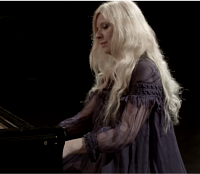
56. The Seasons, “June” Barcarolle Op. 37 Pytor Ilyich Tchaikovsky [6:17]
Valentina Lisitsa, Pianist
Tchaikovsky (1840-1893) is rightfully famous for his great symphonic works, ballets, and concertos. But his solo piano works, though less known, are worthy to be celebrated. He wrote 12 character pieces for solo piano depicting a different month of the year in Russia. Many have been orchestrated nicely, but to hear them on the piano is to indulge in the pure simplicity of the single performer intimately communing with the composer. Interestingly, the Seasons were written after the First Piano Concerto and before the ballet, Swan Lake. By the way, a “Barcarolle” is a boat song reminiscent of gondoliers in Venice. Enjoy a summer idyll!
Selection source: 56. The Seasons, “June” Barcarolle Op. 37
55. Serenade No.10 for Winds ‘Gran Partita’ III. Adagio
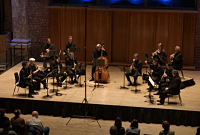
Serenade No.10 for Winds ‘Gran Partita’ III. Adagio, Wolfgang Amadeus Mozart [5:56]
London Symphony Orchestra Wind Ensemble
Mozart amazes us for so many reasons. In his brief life [1756-1791] he composed operas, dozens of symphonies, piano works, songs, masses, requiems, choral works and sets of woodwind pieces. In total over 600 compositions and every single one deserves the accolade of perfection. He was able to conceive an entire large and complex work mentally. Unlike other (even great) composers, he rarely had to work out sketches and rewrites on paper. The only thing that slowed him was the tedium of actually inking the manuscript with the thousands of notes pouring from his head. This Adagio achieved fame via the play (movie) “Amadeus” that was a biographical drama of considerable cleverness. Hearing these melodies soar again reminds us of what transcendent realms the genius in humanity may strive for and even reach.
Selection source: 55. Serenade No.10 for Winds ‘Gran Partita’ III. Adagio
54. Orfeo (1607) Act 2 (ending)
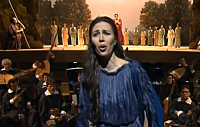
Orfeo (1607) Act 2 (ending) Claudio Monteverdi [15:01]
Le Concert des Nations, La Capella Reial de Catalunya, Jordi Savall—Conductor
In 1607, Claudio Monteverdi (1567-1643) took the ancient Greek tale of Orpheus and created a musical drama complete with orchestra, dancers, singers, staging, costumes, and special effects equal to the fantastic story. Opera, as an art form, witnesses its birth in this seminal composition. This video excerpt comes at the climactic moment to end Act 2, where Orfeo learns of the death of his beloved bride (their wedding celebrated in Act 1). In addition to opera being born we also see the baroque era’s great musical innovation—melody floated above rich continuous harmony. The singer voices words with clarity and emotional affect while the accompaniment underscores meaning with chordal richness that never obscures. Observe how authentically Monteverdi portrays grief. Orfeo upon learning of Euridyce’s death barely speaks—dumbstruck with sorrow. Only after sorrow evolves to anger and resolve does his voice reach a climax of emotion. If you haven’t heard all of Orfeo, find the full 2 hour version of this authentic performance (Savall) and get immersed in it. Even after 400 years this music is heartbreakingly powerful.
Selection source: 54. Orfeo (1607) Act 2 (ending)
53. Variations Seriéuses Op. 54
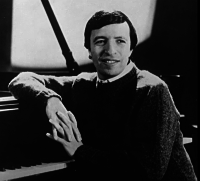
53. Variations Seriéuses Op. 54, Felix Mendelssohn-Bartholdy [11:35]
Murray Perahia—Piano
Mendelssohn (1809-1847) typifies the Romantic movement in its early stages. What is musical Romanticism? Artists (composers) emerge to the foreground of their art. No longer fettered to patrons (royalty, government) the artist stamps his/her art with individuality or personality. Whereas earlier composers (Renaissance, Baroque) might be harder to distinguish one from another, the Romantic composer is unmistakable from their art. Walter Pater defined “Romanticism” as “the addition of strangeness to beauty.” The Serious Variations are a perfect projection of Mendelssohn’s personality. The music progresses through a wide emotional range, disciplined but expressive. The music is undeniably Mendelssohnian—ingenious, carefully crafted and memorable. This music inspires us as much as it soothes us.
Selection source: 53. Variations Seriéuses Op. 54
52. Suite No. 1 in G Major BWV 1007
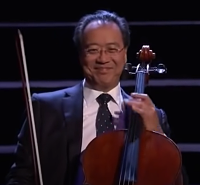
#52. Suite No. 1 in G Major BWV 1007, Johann Sebastian Bach
Yo-Yo Ma—Cello
The greatest performer plus the greatest composer equals the ultimate musical experience. Think of the limitations in composing music for the solo cello. It has four strings in the middle lower register most often used for bass lines and low melody rather than harmony. Yet the great Bach stretches his heightened art of counterpoint (complex combinations of notes played together) to produce the illusion and the reality of rich harmony and polyphony. The performer also must stretch technically to bring such heavenly music to life. The suite is a set of six pieces that follow one another unified by key (G major) and Bach’s ingenious and subtle thematic threads. Furthermore, he uses the arcane dances of the early Baroque to liven the music with endless rhythmic material. If there is music to heal our souls and bodies by virtue of purest perfection, this is it!
Selection source: 52. Suite No. 1 in G Major BWV 1007
51.Frostiana 1. “The Road Not Taken”
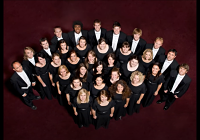
51.Frostiana 1. “The Road Not Taken” Randall Thompson [4:53]
The Boise State University Meistersingers, Dr. Phil Theodorou—Director
In 1959 Randall Thompson (1899-1984) wrote settings of seven poems by Robert Frost on a commission from the town of Amherst, Massachusetts. These seven pieces have now become enshrined in the choral repertoire as the perfect marriage of two American masters. Frost’s poetry is by itself perfect word art. Thompson’s music serves the poems with a nobility that never tarnishes the lustre of the sentiment. If you have time, find the entire set and enjoy their variety and charm. You can find the full text below the video.
Selection source: 51.Frostiana 1. “The Road Not Taken”
50. l’Ascension, III. and IV.

50. l’Ascension, III. and IV. Olivier Messiaen [14:20]
Stavanger Concert Hall Organ (Norway), Olivier Latry—Organist
Olivier Messiaen (1908-1992) was tenured organist at La Trinité church in Paris, a post he held from 1931 until his death. A major composer of the 20th century he synthesized Gregorian Chant, birdsong, Indonesian gamelan, and other global music into a new language of music. Every Sunday he climbed the spiral stairs to the organ loft humbly to accompany services with organ improvisations that reflected the Roman Catholic liturgical themes. He prefaced his music with biblical quotations as the point of inspiration. His music is not easy listening, in fact, it is as hard as the spiritual and intellectual demands of mystical theology. He also emulated the world view of St. Francis of Assisi. These two movements (of four) meditate on the Ascension of Jesus.
Selection source: 50. l’Ascension, III. and IV.
49. Der Hirt auf dem Felsen (The Shephered on the Rock)
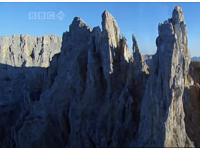
49. Der Hirt auf dem Felsen (The Shephered on the Rock) Franz Schubert [11:38]
Kathleen Battle—Soprano, Clarinet—Karl Leister, Piano—James Levine
A duet between voice and clarinet is already unusual, but the melodic invention of the perhaps the greatest song writer, Franz Schubert (1797-1828) makes for unrivaled bliss. This recording is among the most graceful and touching. The video notes <Show More> tell the story. The video also nicely translates the poem while it is sung. The theme of spring and renewal again appears as a hopeful uplift.
Selection source: 49. Der Hirt auf dem Felsen (The Shephered on the Rock)
48. Candide “Overture”
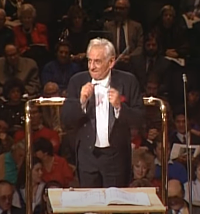
48. Candide “Overture” Leonard Bernstein [4:41]
London Symphony Orchestra (1989) Leonard Bernstein—Conductor
What could be better than hearing and watching dear Lennie performing his own piece? Everything about it is manic! This piece exhibits all the excellent craft of a composer who was at home on Broadway as Orchestra Hall at Lincoln Center. The opera, Candide, based on Voltaire’s abstruse story, rarely got off the ground when staged (even after several rewrites and massive interventions). It opened on Broadway in 1956. But this superb instrumental piece is the gem that outshined the drama. For those who dislike Bernstein’s conducting antics just close your eyes. Otherwise, here we have a man who clearly lived what he loved to the fullest!
Selection source: 48. Candide “Overture”
47. Piano Trio No. 2 Op. 67 -3 Largo
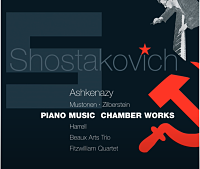
47. Piano Trio No. 2 Op. 67 -3 Largo Dmitri Shostakovitch [5:02]
Beaux Arts Trio
At the height of the Second World War Shostakovitch [1906-1975] wrote this four movement piano trio (piano, violin and cello). We hear the third movement that is the most somber and introspective of the movements. It was premiered in Leningrad in 1944. If you have time to listen to the entire Trio you will discover a wide range of moods. Yet it is this piece that comes to us as particularly poignant because it projects a kind of sustained grief one can imagine all Russia felt in that tragic time. The music is an old form called passacaglia where a theme is repeated as variations build over it. The back story of the Trio involves the Jewish themes that Shostakovitch wove into the music that showed his understanding of their hardships in his time.
Selection source: 47. Piano Trio No. 2 Op. 67 -3 Largo
46. A Geneneral Communion

46. A Geneneral Communion Frederick Frahm [3:45]
The Merbecke Choir, Southwark Cathedral London, Huw Morgan—Conductor
Our friend Frederick Frahm beautifully and poignantly sets to music an anthem on a poem (words below) by Alice Meynell. Meynell in addition to being a significant poet in the Victorian era, was a champion of women’s rights who helped to found the Catholic Women’s Suffrage Society. Fred Frahm is a prolific composer residing in Albuquerque whose works range from the operatic to the symphonic as well as numerous choral works. We are proud to know him. This recording, appropriately from a London cathedral, is splendid.
Selection source: 46. A Geneneral Communion
45. Le Bourgeois Gentilhomme, LWV 43: Ouverture (1670)
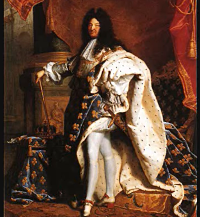
45. Le Bourgeois Gentilhomme, LWV 43: Ouverture (1670) Jean-Baptiste Lully
Le Concert des Nations, Jordi Savall—Conductor
He died from his music. Jean-Baptiste Lully (1632-1687) was born in Florence. At fourteen was brought to France to tutor Italian to an aristocrat’s niece, became her chamber boy, entered the court of Louis XIV and eventually was appointed superintendent of the king’s music, innovated new music at court including numerous operas and ballets collaborating with Molière, fell out of favor with the king, and died from gangrene after stabbing himself in the foot with his conducting staff. His life reads like a novel and his music could make a great film score (and it has)! This music is the opening to the named Molière comedy. Grand and majestic, lively and jaunty, the overture bears the very image of the king who was a great patron of the arts.
Selection source: 45. Le Bourgeois Gentilhomme, LWV 43: Ouverture (1670)
44. Sonata in Trio (1695)
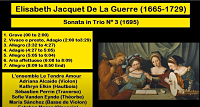
44. Sonata in Trio (1695), Elisabeth Jacquet De La Guerre [8:54]
L’ensemble Le Tendre Amour
Elisabeth Jacquet De La Guerre (1665-1729) played the harpsichord as a child prodigy for the king, Louis XIV. Her career as a performer and composer was acclaimed in her lifetime. Today she stands tall in the company of the French Baroque composers, Lully, Couperin, and Rameau. She wrote operas, chamber music, and extensively for the harpsichord. This recording offers historically authentic instruments and style very admirably.
Selection source: 44. Sonata in Trio (1695)
43. D’un matin de printemps

43. D’un matin de printemps Lili Boulanger [5:54]
Seattle Symphony Cristian Măcelaru—Conductor
Marie-Juliette Olga “Lili” Boulanger (1893-1918) was the first woman to win the Prix de Rome with the composition prize in 1913. A composer of great promise she showed the influence of two contemporary masters, Gabriel Fauré and Claude Debussy. She suffered greatly from a chronic illness that began with bronchial pneumonia as a child. Her life ended at age 24. This short piece shows her orchestration gift for mixed instrumental tone coloring. It is truly “From a Spring Morning.” Her sister Nadia Boulenger (1887-1979) outlived her and was one of the greatest composition teachers of the 20th century. Nadia tutored the likes of Aaron Copland, Philip Glass, Roy Harris, Quincy Jones, Astor Piazzolla and others. Both sisters are significant composers of the modern era.
Selection source: 43. D’un matin de printemps
42. Concerto for Orchestra V Finale
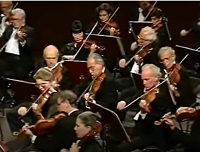
42. Concerto for Orchestra V Finale, Bela Bartok [9:31]
Boston Symphony Orchestra, Seiji Ozawa
Bela Bartok (1881-1945) wrote Concerto for Orchestra in 1943 and the Finale is truly manic, just the kind of exuberance we need nowadays. If you aren’t familiar with this work or his music in general, it is a must to hear all five movements. But, for now, this taste perhaps is the right medicine for a world filled with restriction and isolation. It was commissioned by Serge Koussevitsky the famed conductor of the Boston Symphony Orchestra. The commission re-energized Bartok and resulted in several other works of excellence just before his death.
Selection source: 42. Concerto for Orchestra V Finale
41. All-Night Vigil #5 “Nyne Otpushchayeshi”
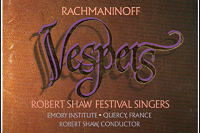
41. All-Night Vigil #5 “Nyne Otpushchayeshi” Sergei Rachmaninoff [4:05]
Karl Dent—Tenor, Robert Shaw Festival Singers, Robert Shaw—Conductor
If there is an archetypal music to envision heaven, this is it. The Russian Orthodox Divine Liturgy asks the worshiper upon entering the church to leave behind the earth and enter heaven. Time ceases and is replaced by eternity. The service does not “begin” because it has always been going on. The image wall—iconostasis—fixes all eyes upon the Mary, Jesus, the saints of heaven. Vocal music blankets the service. Rachmaninoff captures these senses of worship with music that seems to hover in the air like clouds of incense. The Song of Simeon or “Nunc dimittis” recalls the old man upon seeing the child, Jesus, in the Temple, prays that his long life may now end, his wait for the Messiah has ended. There are 15 sections to the All-Night Vigil most based upon the ancient chants of the Orthodox tradition. Do find and listen to the entire composition after this taste of heavenly music! The Robert Shaw recording is available online and it is the epitome.
Selection source: 41. All-Night Vigil #5 “Nyne Otpushchayeshi”
40. Sonate on the 94th Psalm
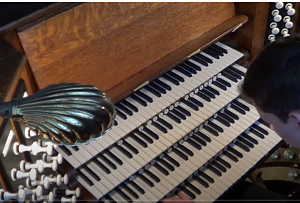
40. Sonate on the 94th Psalm Julius Reubke [25:17]
Kings College Cambridge Organ, Richard Gowers—Organist
Some geniuses burn brightly but briefly as this composer at age 22. Julius Reubke (1834-1858) showed dazzling keyboard gifts early on impressing even the greatest virtuoso of the day, Franz Liszt. He wrote this monumental organ sonata and performed it in 1857. This lengthy tone poem uses Psalm 94 (see below) as its inspiration. It is a wrathful and stormy psalm and the music displays it. It is a masterpiece of German Romantic style that Liszt, and later organist, Max Reger, celebrated. This is a lengthy work, but if you stick with it to the end you will not regret the musical journey. Kings College organ is a romantic style organ. The player Richard Gowers was 22 at the time of this video and his youthful energy is matched by his maturity of expression.
Selection source: 40. Sonate on the 94th Psalm
39. Italian Madrigal “Ride la Primavera”
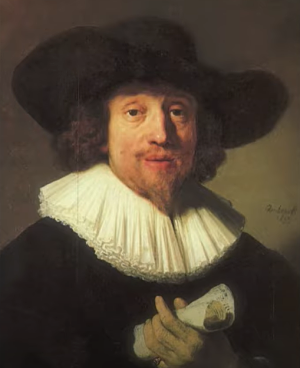
39. Italian Madrigal “Ride la Primavera” Heinrich Schütz [3:07]
Concerto Vocale, René Jacobs
While the 18th century has J.S.Bach as its greatest composer, the 17th century boasts Heinrich Schütz [1585-1672]. His life spanned 87 years and his music reflected the paradigm shift from Renaissance to Baroque. The young, 26 year-old wrote this madrigal in 1611 showing the influence of another great contemporary master, the Italian, Claudio Monteverdi (see #27). The delightful poem celebrates the season personified in Clori, perhaps in the image of a coy shepherdess. The music is playful painting pictures of words beginning with a musical “laugh” on “Ride” then the birdsong of the swallow, the new season “stagion” dances, the notes nearly freeze on “ghiaccio” or ice. Even if you find the Italian hard to discern, the playful voicings convey a joy we all know when winter snows give way to flowers.
Selection source: 39. Italian Madrigal “Ride la Primavera”
38. Ecco La Primavera
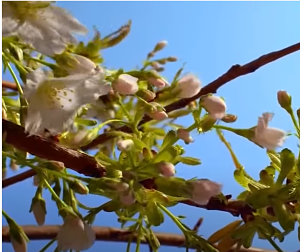
38. Ecco La Primavera, Francesco Landini [3:21]
Stepan Prenosil, Zdenek Seidl, Petr Kalvoda, Ludek Pechacek, Jan Bachor—Ensemble Řemdih
Spring has arrived! Seven centuries ago music and art of the Middle Ages were very much alive if not evolving. Witness this ballata or two-part song with its unbridled lust for life. Landini [1325-1397] composed music that presaged a new age, the Renaissance.
Selection source: 38. Ecco La Primavera
37. “You Go To My Head”
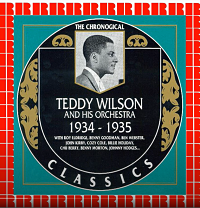
37. “You Go To My Head” Fred Coots (music) & Haven Gillespie (lyrics) [3:17]
Billie Holiday—vocalist, Teddy Wilson—Piano
The year was 1938, the depths of the Great Depression, and this song with words by Haven (James Lamont) Gillespie (1888-1975) and the finely crafted music of John Frederick Coots (1897-1985) caught the attention of many jazzers including Teddy Wilson (see playlist #32 ) and the legendary Billie Holiday (1915-1959). This early Holiday recording likely was cut in 1938 and it has the youthful singer at her best. Everything about this piece calls for repeated listening—the melody and harmony weaving from major to minor, the lyrics filled with clever internal rhymes, the vocalist adding her glosses, and, of course, Teddy with his keyboard magic. In this music one might imagine a shadowy film noir scene, or the painted loneliness of Edward Hopper’s famed “Nighthawks.”
Selection source: 37. “You Go To My Head”
36. Piano Quintet in F-Sharp Minor, Op. 67, III Allegro agitato

36. Piano Quintet in F-Sharp Minor, Op. 67, III Allegro agitato Amy Beach [9:04]
Eliot Heaton—violin, Ran Cheng—violin, Colin Brookes—viola, SeuanAh Hong—cello, Solungga Liu—piano
Amy (Marcy Cheney) Beach (1867-1944) began as a child prodigy on the piano. Not only musically gifted, she was a genius teaching herself to read at age three among other things. She performed with the Boston Symphony as piano soloist at age 16. At 18 she married a prominent physician, Dr. Henry Beach who asked her to curtail public performances. Thus, she focused her efforts on composition pouring her restricted energies into her own music. As a composer she was self-taught as well. After Dr. Beach died in 1910, she revived her career and toured Europe achieving wide recognition as a composer and performer. She wrote a prize-winning Mass, chamber music (like this piano quintet), symphonies, and other large works. She is one of America’s great treasures. She championed the cause of American women composers.
Selection source: 36. Piano Quintet in F-Sharp Minor, Op. 67, III Allegro agitato
35. Lux aurumque

35. Lux aurumque Eric Whitacre
Virtual Choir of 185 voices, Eric Whitacre—Conductor/Composer
In this time of incredible solitude (not to mention forced silencing of so many choirs and orchestras) Eric Whitacre launched in 2010 the idea of a virtual choir that remains astounding musically as well as a prescient solution for musicians in 2020. If you have heard and seen this video perhaps you can attest with me the emotional power it manifests on first view. Some music, even without knowing what it “means” achieves the sublime in human experience—inspiring awe like a first view of the Hubble images of distant nebulae. Again, I urge using the best sound to listen—headphones or the like. Be astounded!
Selection source: 35. Lux aurumque
34. St. Paul’s Suite
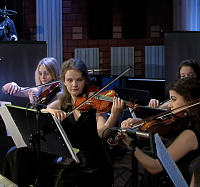
34. St. Paul’s Suite, Gustav Holst [14:56]
Eufonico String Orchestra, Rafel Nicze—Conductor (at the 3rd Polish Nationwide Music Schools’ Symphonic Orchestras Competition)
Nothing fills my heart with joy as hearing youthful players achieve excellence. This recording wins the prize. The young women in this school orchestra perform with maturity and impressive skill. Gustav Holst (1874-1934) wrote this music while on the faculty of St. Paul’s Girls School in 1904. Each short movement pays homage to English dances and songs. In particular the icing on the cake comes in the Finale when Holst mixes the Dargason (a kind of country dance) with the tune Greensleeves so cleverly.
Selection source: 34. St. Paul’s Suite
33. Mathis der Maler 1. Englekonzert
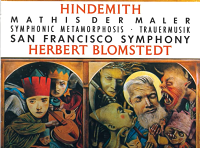
33. Mathis der Maler 1. Englekonzert, Paul Hindemith [8:24]
San Francisco Symphony, Herbert Blomstedt—Conductor
Hindemith: Symphonie ‘Mathis der Maler’ / Trauermusik / Symphonic Metamorphosis
℗ 1988 Decca Music Group Limited
Selection source: 33. Mathis der Maler 1. Englekonzert
32. Liza “All The Clouds’ll Roll Away”

32. Liza “All The Clouds’ll Roll Away” George Gershwin
Introducing (if you aren’t already familiar) Teddy Wilson (1912-1986), one of the most gifted pianists, whose music will lift your heart with his astounding keyboard technique! George Gershwin (1898-1937), another American musical genius, typified the composers of Tin Pan Alley and blended classical music with Broadway. Teddy Wilson made his own arrangements of this tune that Gershwin wrote in 1929. This melody kept lightness alive during the dark days to follow in the great Depression
Selection source: 32. Liza “All The Clouds’ll Roll Away”
31. “Ebben! Ne Andro Lontana (La Wally), Alfredo Catalani
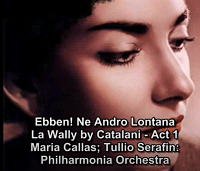
31. “Ebben! Ne Andro Lontana (La Wally), Alfredo Catalani [4:56]
Maria Callas, Philharmonia Orchestra, Tullio Serafin—Conductor
Opera can claim some of the most deeply emotional music written. This aria from a seldom performed opera is such a piece. The great soprano, Maria Callas, gives us the gold standard in her mastery of expressive singing. Although the story of the opera is tragic, and this aria a key moment in it, the music fulfills our craving for beauty through its vocal purity and the splendid orchestration. You can follow the words as you listen (subtitles). Enjoy!
Selection source: 31. “Ebben! Ne Andro Lontana (La Wally), Alfredo Catalani
30. Toccata and Fugue in F major (BWV 540)
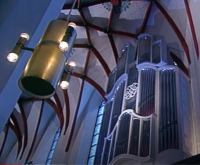
30. Toccata and Fugue in F major (BWV 540), Johann Sebastian Bach (14:14)
Organ of St. Thomaskirche, Leipzig, Germany, Ullrich Böhme
Time for something truly spectacular, thrilling, and exuberant! For organists (and many others) J. S. Bach’s music is the summit and the (I love this next word and have to use it) apotheosis of the Baroque, if not of all European music! In this Easter season I can think nothing better than this organ music: it is a perfection of joy, majesty, and glory. Bach served as cantor at Thomaskirche from 1723 until his death in 1750. As cantor he was in charge of all music, directing ensembles, composing hundreds of choral works as well as organ works.
Selection source: 30. Toccata and Fugue in F major (BWV 540)
29b. In Bright Mansions Above, African-American Spiritual
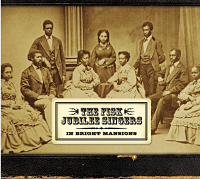
b. In Bright Mansions Above African-American Spiritual [3:22]
Fisk Jubiliee Singers 2003
The second piece, (b) In Bright Mansions Above, contrasts with a different style. In particular note the breathtaking ending where the upper voices float one note effortlessly while the chorus executes the most controlled decrescendo (softening) imaginable!
Selection source: 29b. In Bright Mansions Above, African-American Spiritual
29a. Wade in the Water, African-American Spiritual

a. Wade in the Water, African-American Spiritual [3:42]
Fisk Jubilee Singers 2003
Fisk University in Nashville began as school for freed slaves in 1865 just after the end of the Civil War. The Fisk Jubilee Singers formed by students set out in 1871 to raise funding for the University. They immediately became renowned even touring to Europe. They sang for Queen Victoria and other heads of state. To this day their sound and tradition are an American treasure. Here are two spirituals that so beautifully display the glorious choral tone and the nuanced singing of music that is foundational in the American experience.
Note in the first selection, (a) Wade in the Water, the skillful soloist whose vocal ornamentation shows real delicacy.
Selection source: 29a. Wade in the Water, African-American Spiritual
28. Chaconne D’Alcione

28. Chaconne D’Alcione Marin Marais [6:45]
Le Concert Des Nations, Jordi Savall—Director
Throughout the ages dance has been an essential part of human culture. Nowadays, except for ballroom dancing—itself an almost lost art, formal, patterned social dance only survives as square dance. Not so prior to the 20th century. In 17th century France not to dance would be to made an outcast in the court and palace. Though the early court dances have faded from view, the music remains vibrant and fills the imagination with joyous visions of elegant if not lusty life. Here we have the great Marin Marais (1656-1728) writing for a king—THE KING, aka the Sun, the I-am-the-State, King Louis XIV (1638-1715) , who himself flattered himself a most accomplished master of dance.
Selection source: 28. Chaconne D’Alcione
27. Vespers della Beata Vergine: Laudate pueri (Psalm 112)
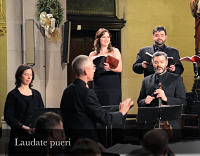
27. Vespers della Beata Vergine: Laudate pueri (Psalm 112) Claudio Monteverdi [6:47]
The Green Mountain Project, Scott Metcalfe—Music Director
Psalm 112 declares with children’s voices all the ways to bless God’s holy name. From the depths of earth to the heights of heaven the proclamation resounds. And God from high looks favorably on the earth at all who live there, from the most humble servants to the most elevated rulers. God’s mercy pours equally on all. It is a song of great joy. Monteverdi (1567-1643) invented a new kind of music in 1610 that ushered in a new style now called “Baroque.” This musical style deals with as many mood changes and as the rich a vocabulary as the psalm.
Selection source: 27. Vespers della Beata Vergine: Laudate pueri (Psalm 112)
26. Isle of the Dead, Op. 29
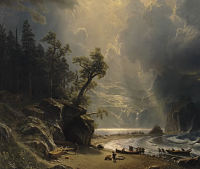
26. Isle of the Dead, Op. 29 Sergei Rachmaninoff [21:10]
Royal Concertgebouw Orchestra, Vladimir Ashkenazy—Conductor
A painting that Rachmaninoff saw in 1907 depicting the Isle of the Dead was so stirring that he immediately conceived this huge tone poem. Hope resonates throughout in ways similar to Christian (and other) afterlife theologies. Musically interesting is the fact that Rachmaninoff uses a Gregorian Chant theme, the ancient Sequence: Dies irae of the Mass for the Dead. The Isle of the Dead is built almost entirely on the first four notes of the Dies irae—Fa-Mi-Fa-Re (even if you don’t know a note of music this theme will come to you). It is astounding that twenty-plus minutes of music can engage us without any boredom despite this omnipresent theme. The composer’s genius was to orchestrate with myriads of tone colors to ensure a gripping musical journey.
Selection source: 26. Isle of the Dead, Op. 29
25. Symphony 3, Symphony of Sorrowful Songs, Op. 36, 2- Lento e largo Tranquillissimo
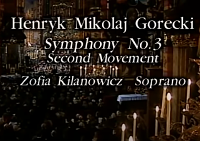
25. Symphony 3, Symphony of Sorrowful Songs, Op. 36, 2- Lento e largo Tranquillissimo Henryk Mikołaj Górecki [9:02]
Zofia Kilanowicz, Soprano, London Philharmonic Orchestra, Sir Gilbert Levine—Conductor
Henryk Mikołaj Górecki (1933-2010) was a Polish composer who lived through the horrors of the Second World War followed by the Russian domination of Poland yet he survived and flourished in his music. In 1976 he wrote Symphony of Sorrowful Songs to memorialize his knowledge of tragedy using music. Like Mahler (see #24) his music demands time to pause, reflect and understand truly deep suffering via music. This is music we must hear see in its humanity what resilience exists in us. I greatly urge you to listen to the entire 3rd Symphony.
Selection source: 25. Symphony 3, Symphony of Sorrowful Songs, Op. 36, 2- Lento e largo Tranquillissimo
24. Symphony 2 “Resurrection” Mvt. 5 (part 2), “O glaube, mein Herz, o glaube”
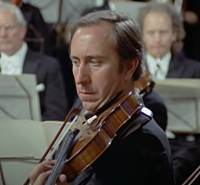
24. Symphony 2 “Resurrection” Mvt. 5 (part 2), “O glaube, mein Herz, o glaube” Gustav Mahler [8:25]
Sheila Armstrong, Soprano, Janet Baker, Mezzo-Soprano, London Symphony Orchestra, Leonard Bernstein—Conductor
Mahler Symphonies are long by any standard. His Symphony 2, has five movements (sections) and lasts well over 90 minutes. The last movement (5) alone is over 20 minutes. One must surrender time in favor of beauty especially with Mahler. I recommend strongly taking the time to listen to his symphonies abandoning all concerns except to be immersed in his nearly endless landscape of tone. This is perfect music when traveling alone out west where the horizon seems unreachable, the music is equal to the journey. Here, however, we have a tiny 8 minute excerpt of this monumental piece, but what a slice to savor. Here Mahler affirms that Life itself mocks Death. Like the Easter message, love conquers pain and death. This music is transcendent. Enjoy a taste of Mahler, and if your appetite is whetted enough, make your pleasure to listen to all of this symphony, and then, since we all have nothing if not Time these days, make it your “musical bucket list” to listen to all NINE Mahler symphonies. All are as glorious and sublime as this excerpt. I promise!
Selection source: 24. Symphony 2 “Resurrection” Mvt. 5 (part 2), “O glaube, mein Herz, o glaube”
23b. O Thou Who Camest from Abov
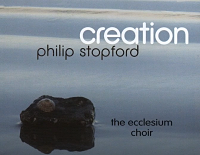
b. O Thou Who Camest from Above, Philip Stopford [3:36]
Ecclesium in Keble College Chapel, Oxford, England, Philip Stopford—Director
Provided to YouTube by The Orchard Enterprises
Selection source: 23b. O Thou Who Camest from Abov
23a. Hymn to the Creator

a. Hymn to the Creator, Philip Stopford [2:12]
Ecclesium in Keble College Chapel, Oxford, England, Philip Stopford—Director
The British composer, Philip Stopford (b.1977), began as a chorister in Westminster Abbey. Listen to two fine examples of his craft. (Read more at Wikipedia). Interestingly, he now works in Bronxville, NY as Music Director. The words appear in the video for the Hymn to the Creator.
Selection source: 23a. Hymn to the Creator
22. Cantata 4 Christ lag in Todesbanden

Cantata 4 Christ lag in Todesbanden, Johann Sebastian Bach [22:26]
Ensemble Orlando Fribourg, Choir and Orchestra, Laurent Gendre—Conductor
Christ lag in Todesbanden, became one of the Reformation’s greatest musical jewels in the crown of reformed sacred music. Bach 150 years later wrote a cantata using the seven verses of Luther’s reformed hymn. The cantata in Bach’s day was a veritable sermon in song. The cantata offered theology through musical symbols, imagery and story. Cantata 4 tells the resurrection story now using full accompaniment of singers and orchestra. Verse by verse we hear a musical battle between Death and Life. Bach treats each of the verses according to the images in the poem. For instance in verse 5 the chorus music with its crossing parts and agitated rhythms may symbolize the strife in battle. Bach also keeps the signature melody in every verse stated in plain notes called the cantus firmus which literally means the fixed chant, i.e., the chant that is not changed.
Selection source: 22. Cantata 4 Christ lag in Todesbanden
19. Victimae Paschali laudes, Easter Sequence
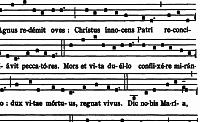
Victimae Paschali laudes, Easter Sequence, Gregorian Chant [2:27] Benedictine Monks of Triors Abbey
The Easter chant or Sequence, Victimae Paschali laudes (see translation below), is itself a work of high art. It likely originated in 11th century France. The chant functioned as processional music that followed (thus the name sequence = to follow) the great Easter Alleluia as the Gospel book ceremoniously was carried to a place of prominence. The chant narrates the Easter resurrection story. It also portrays Easter as a battle between Death and Life, where Death (Sin) is conquered by Life (Christ). The chant has a signature melody easy to remember and which is repeated within the melody so that churchgoers heard the first eight notes as a signal of the Easter season. The chant declares the Latin words plainly, one syllable per note. The chant was simple, declarative, and memorable and so it became the battle hymn of Easter.
Selection source: 19. Victimae Paschali laudes, Easter Sequence
18. Chorale-Improvisation on Victimae Paschali laudes
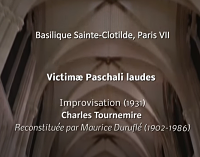
Charles Tournemire (1870-1939) Victimæ Paschali laudes Choral-Improvisation (1931) reconstituée par Maurice Duruflé (1902-1986)
Olivier Penin aux grandes orgues de la Basilique Sainte-Clotilde, Paris VII.
Charles Tournemire (1870-1939), like many organists, served decades at one church in Paris. Tournemire was the tenured organist at Cesar Franck’s famed organ in Basilica of St. Clothilde from 1898 until his death 41 years later. Gregorian Chant was much alive through his life and he found the timeless chant melodies a rich source of inspiration. Moreover, Tournemire, as with so many organists then and now, loved to improvise at the keyboard. He recorded a number of brilliant improvisations on 78 rpm phonographs in 1930. This treasure of music was later transcribed by another great organist and composer, Marice Durufle.
Selection source: 18. Chorale-Improvisation on Victimae Paschali laudes
17. Five Mystical Songs for baritone solo chorus and orchestra
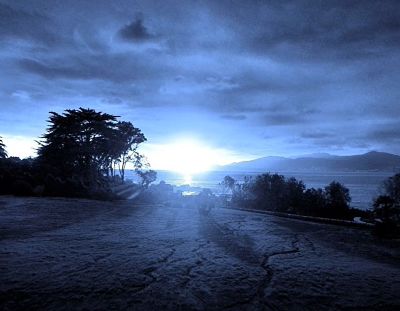
Album
for baritone solo chorus and orchestra
Nothing could be more in the spirit of Eastertide than the Five Mystical Songs. Its extraordinary poetry alone would recommend it. Vaughan Williams’ genius for setting words to music, however, lends a new dimension to the title “Mystical.” Welsh-born and Anglican Priest George Herbert (1593-1633) wrote the poems that Ralph Vaughan Williams set to music in 1911.
Selection source: 17. Five Mystical Songs for baritone solo chorus and orchestra
16. Planxit autem David: Montes Gelboe Josquin de Prez

Planxit autem David: Montes Gelboe Josquin de Prez [2:17]
Capella Amsterdam, Daniel Reuss—Director
Ye mountains of Gelboe, let neither dew nor rain fall upon you, nor be they fields of offerings:
for there the shield of the mighty is cast away, the shield of Saul,
as though he had bot been anointed with oil.
From the blood of the slain, from the fat of the mighty.
Selection source: 16. Planxit autem David: Montes Gelboe Josquin de Prez
15. Montes Gelboe Antiphon, Gregorian Chant
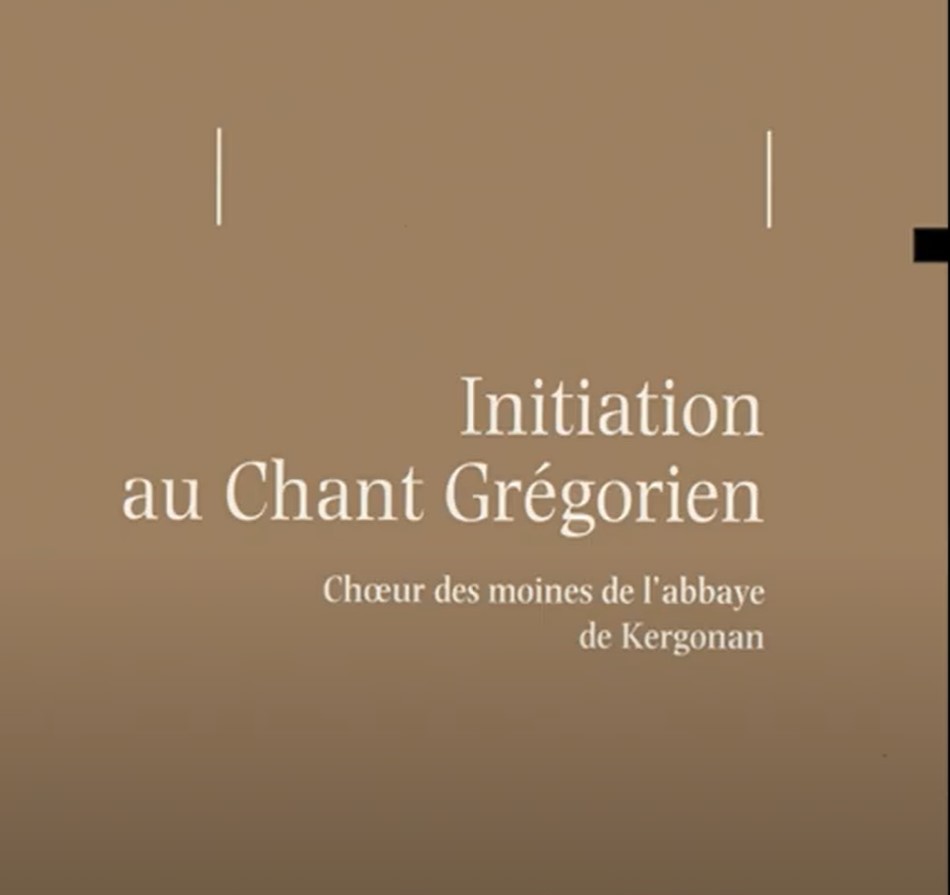
Montes Gelboe Antiphon, Gregorian Chant [2:15]
Choir of Monks of the Abbey of St. Anne de Kergonan
2 Samuel 1:20-24,
Ye mountains of Gelboe, let neither dew, nor rain come upon you,
for there was cast away the shield of the valiant, the shield of Saul as though he had not been anointed with oil.
How are the valiant fallen in battle? Jonathan is slain upon thy high places.:
Saul and Jonathan, lovely, and pleasant in their life, even in death they were not separated.
Selection source: 15. Montes Gelboe Antiphon, Gregorian Chant
14. Philip Glass: String Quartet No. 2, “Company”
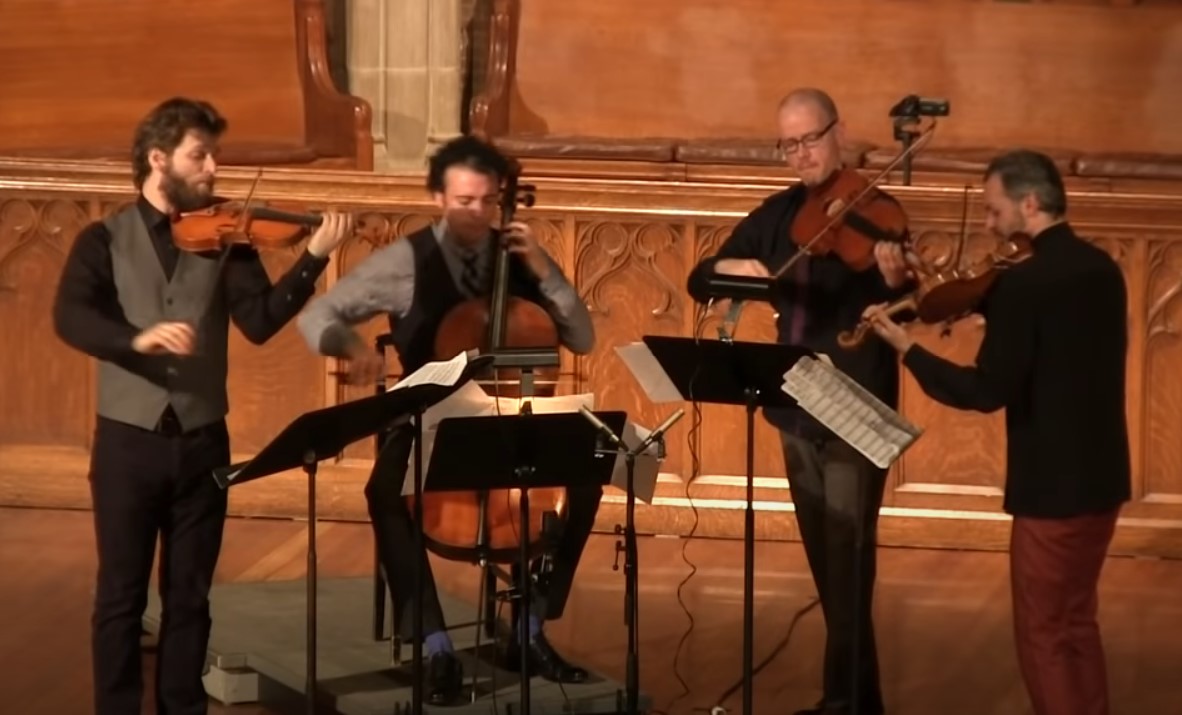
Brooklyn Rider performs Philip Glass’s String Quartet No. 2, “Company” at Wellesley College in early 2014.
This string quartet (1983) is both representative and unusual for Philip Glass. Representative with his characteristic minimalism wherein the insistent and unrelenting motor of the music creates something like an aural kaleidoscope—ever changing patterns that evolve in tiny increments.
Selection source: 14. Philip Glass: String Quartet No. 2, “Company”
13. Roy Harris (Symphony No. 3)
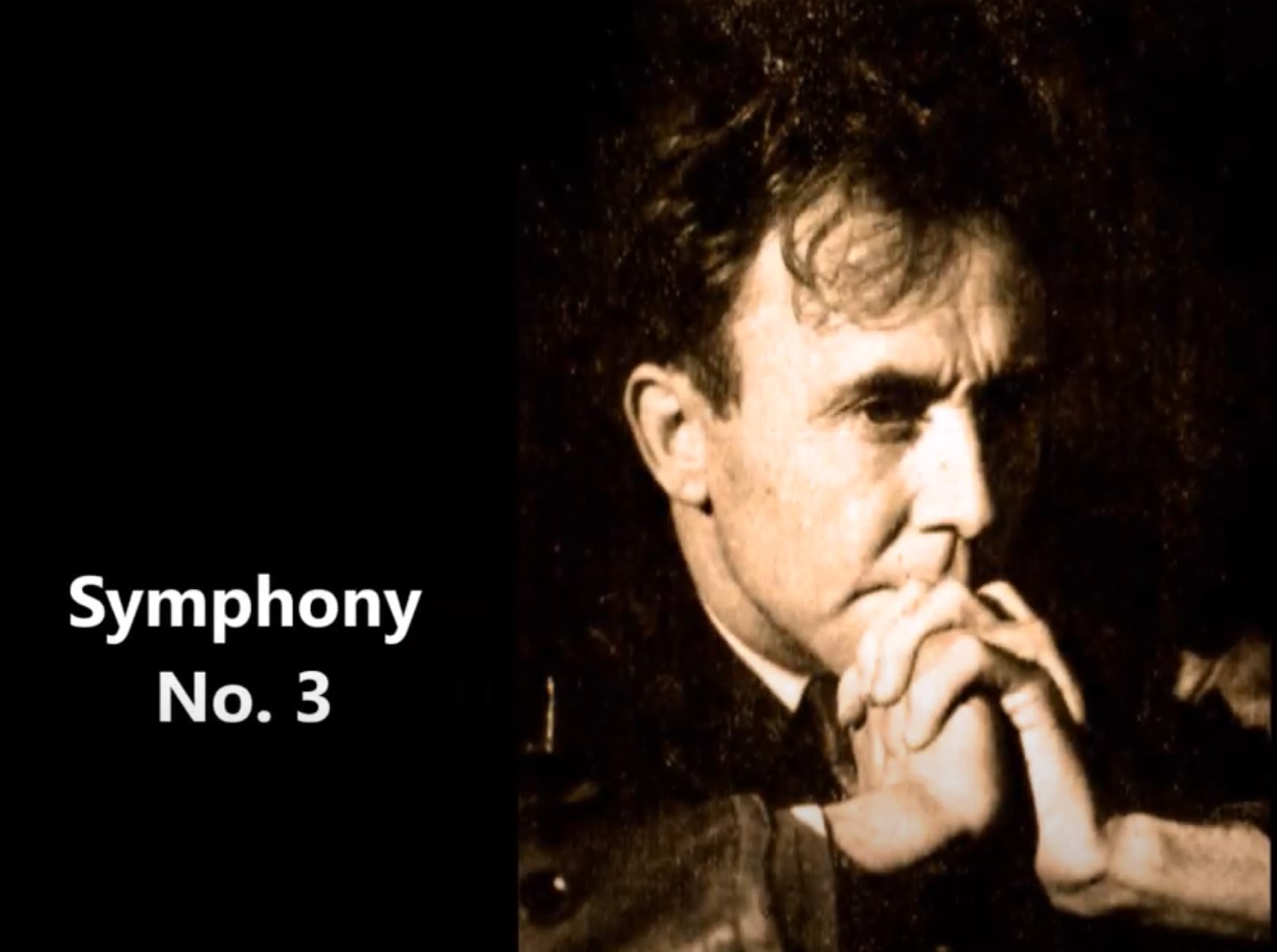
Symphony 3 (In one movement), Roy Harris [17:52]
Colorado Symphony Orchestra, Marin Alsop—Conductor
Like Leonard Bernstein (#15) Roy Harris created a musical landscape that is 100% American—rugged, optimistic, soul-filled, bold, brash, tender, and with lots and lots of heart! If you know this piece, I don’t need to say more—it is one of the best examples of our culture, a product of stellar craft in tone, and an equal to any visual art, architecture or invention we proudly say “Made in America.”
Selection source: 13. Roy Harris (Symphony No. 3)
12. Chichester Psalms (1965) Leonard Bernstein
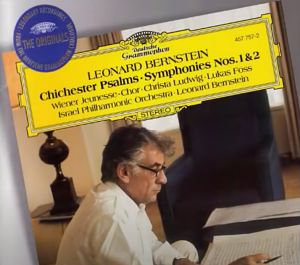
Bernstein hugely exceeded expectations writing essentially one of his most masterful works, and perhaps even a landmark of the 20th century. The psalms are Hebrew in origin. And the psalms were meant to be sung (never just spoken). Bernstein joins several psalms in each of the three movements. You will note that Psalm 23, is broken in two parts, interrupted really by a very angry and tumultuous Psalm 2 and this is very telling. The music of the Chichester Psalms is Bernstein unabashedly painting sounds with the full colors of his musical palette—Broadway, to symphonic, to church motet. Above all it is a work of hope and joy in the midst of the world’s strife.
Selection source: 12. Chichester Psalms (1965) Leonard Bernstein
11. Messiah Chorus “Worthy Is The Lamb”

Messiah Chorus “Worthy Is The Lamb” George Friedrich Handel [7:17]
The Choir of Kings College, Cambridge, Sir Stephen Cleobury—Director
How do you end an oratorio that lasts almost 3 hours? With a big rousing “Amen.” Although everyone associates the Easter feast with the famed Hallelujah Chorus (which actually comes in the middle of the oratorio) the ending chorus “Worthy Is the Lamb” in many ways surpasses it in sheer power and majesty. Where better to hear this work than in England at one of the most highly regarded choral institutions, the Choir of Kings College.
Selection source: 11. Messiah Chorus “Worthy Is The Lamb”
10. St. Matthew Passion Chorus #78 “Wir setzen uns mit Tränen”
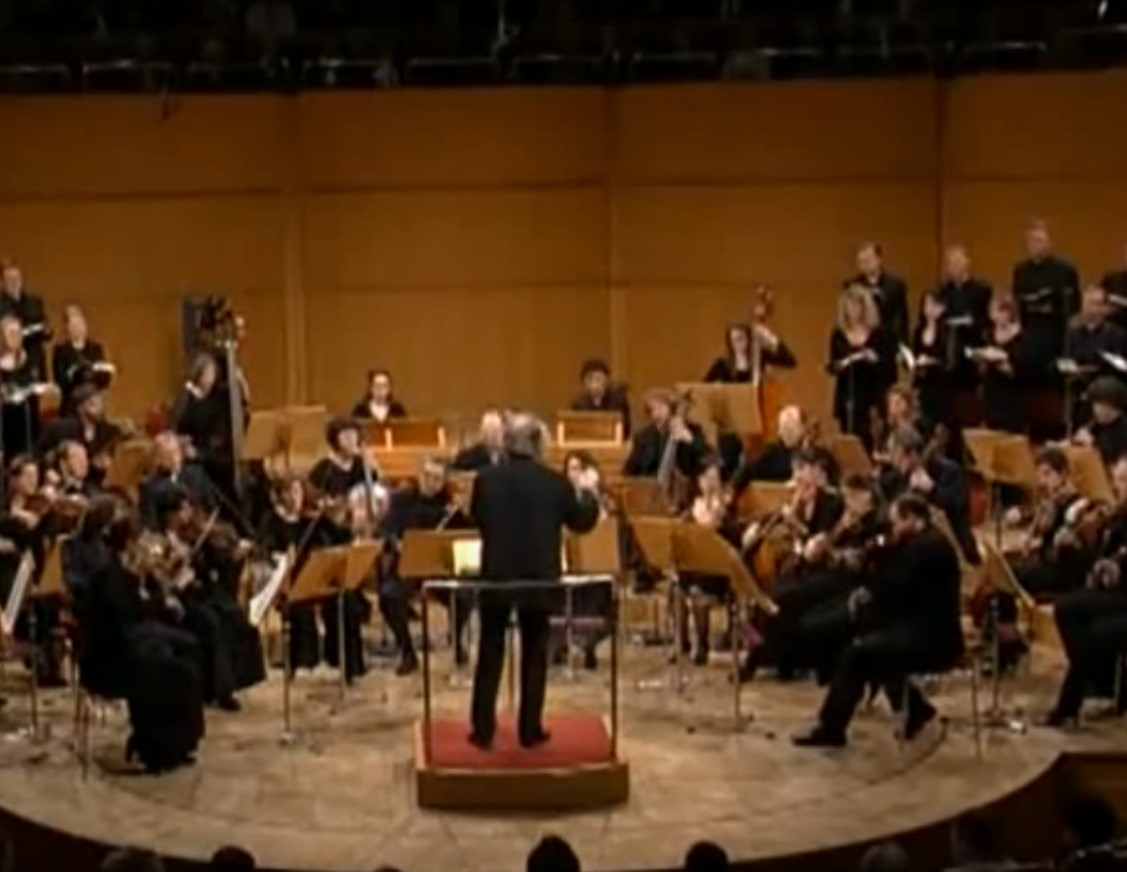
St. Matthew Passion Chorus #78 “Wir setzen uns mit Tränen” Johann Sebastian Bach [5:17]
Collegium Vocale Ghent, Philippe Herreweghe, Director,
Imagine a world where worshipers would on Good Friday attend a three hour church service made solely of music. Yet such a world did exist in Leipzig Germany at Thomaskirche, April 11, 1727 at the first playing of Matthew Passion. Thomaskirche has two choir lofts so Bach took advantage of them with a larger chorus and orchestra in the big loft and a smaller chorus in the lesser loft. This allowed a dialogue between groups as well as dramatic echo effects. It must have been an immersive experience for the congregation when the two ensembles joined together as in this final chorus “We Sit Down in Tears.”
Selection source: 10. St. Matthew Passion Chorus #78 “Wir setzen uns mit Tränen”
9. Deutches Requiem Movt. 2 “Denn alles Fleisch, es ist wie Gras” Berlin Philharmonic Orchestra

JOHANNES BRAHMS (1833 - 1897)
Ein deutsches Requiem op. 45
II. Denn alles Fleisch, es ist wie Gras
We return to the German Requiem of Brahms to hear the second movement, “For All Flesh Is as Grass.” This movement is about the fleeting nature of our lives, about time as the psalmist says which “like and ever flowing stream bears us all away.” The idea, also, that God is timeless, eternal and, moreover, that the word of God lasts forever. This music clearly marks time with the beating of the kettle drums. It marches forward relentlessly as the music builds several times into ever stronger climaxes. Brahms imbues the music with a strength and power that culminates finally in a grand fugue of redemption. The image is of all souls on earth passing through death into the life beyond life that is timeless.
Selection source: 9. Deutches Requiem Movt. 2 “Denn alles Fleisch, es ist wie Gras” Berlin Philharmonic Orchestra
8. O Divine Redeemer - Mormon Tabernacle Choir

The Mormon Tabernacle Choir performs “O Divine Redeemer” by Charles Gounod with lyrics by Alfred Phillips.
Episode 4348. Aired January 13, 2013
Charles Gounod (1818-1893) wrote this most beloved of religious pieces six months before he died. He never heard it performed. It was received with immediate acclaim. Even the pope claimed it as his official anthem. Entitled “Repentir” the English translation is faithful to the original French poem that Gounod also wrote. The music, though rhapsodic in the style of late Romanticism, is just restrained enough to touch our hearts with a moderate sentimentality.
Selection source: 8. O Divine Redeemer - Mormon Tabernacle Choir
7. Brahms ~ Ein Deutsches Requiem, Op. 45 (V/VII) ~ Herbert von Karajan

Ein Deutsches Requiem Movt. 5 “Ihr habt nun Traurigkeit,” Johannes Brahms, Kathleen Battle—Soprano, Herbert Von Karajan—Conductor [8:15]
Brahms wrote the German Requiem between 1865-1868 possibly motivated by grieving over his mother’s death. Of the seven movements the fifth offers us the most solace in the face of our mortality. Brahms drew his texts from the Bible (as opposed to the traditional Requiem Mass of the Roman Rite) and gave Scriptures truly heavenly voicing. This superb recording with the maestro Van Karajan at his best brings the music a transcendence only topped by the astonishing voice of Kathleen Battle.
Selection source: 7. Brahms ~ Ein Deutsches Requiem, Op. 45 (V/VII) ~ Herbert von Karajan
6. St. Matthew Passion Aria #39 “Erbarme dich mein Gott”
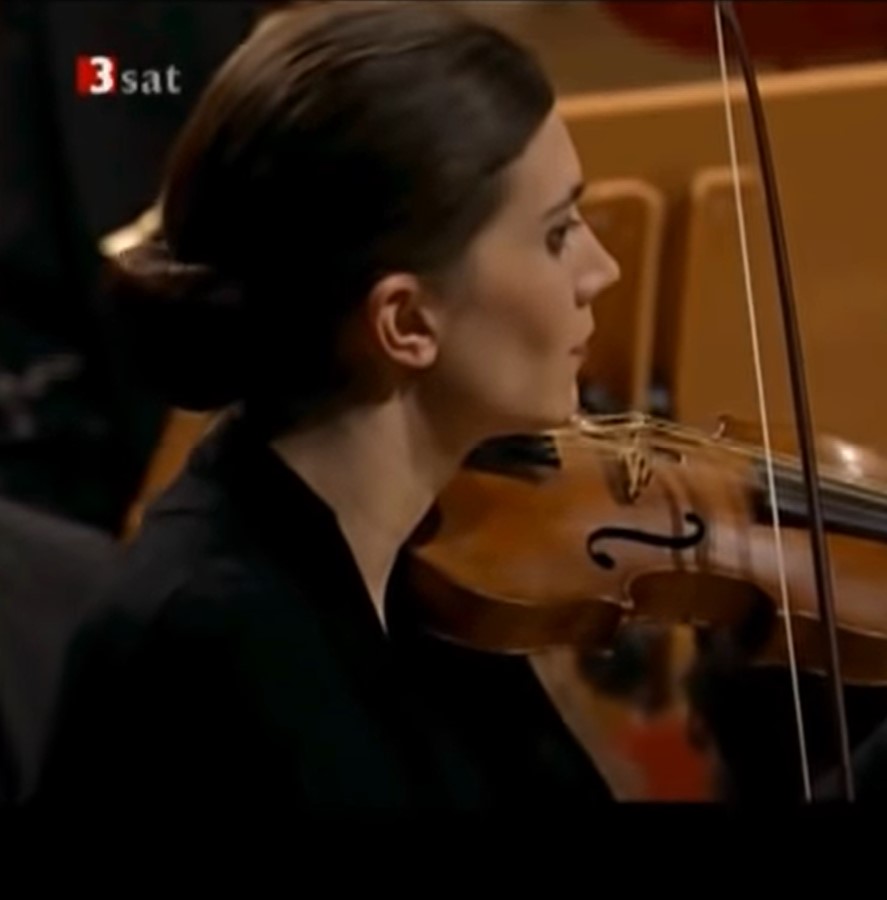
Johann Sebastian Bach (1685-1750)
Matthäus-Passion BWV244
Damien Guillon alt,
Choir and Orchestra of Collegium Vocale Ghent
Direcció musical: Philippe Herreweghe
Concert - 28 de març de 2010, Kölner Philharmonie
Selection source: 6. St. Matthew Passion Aria #39 “Erbarme dich mein Gott”
5. Motet: Plus bele que flor/Quant revient/L’autrier joer/Flos filius eius

Selection source: 5. Motet: Plus bele que flor/Quant revient/L’autrier joer/Flos filius eius
4. Sit Down Servant
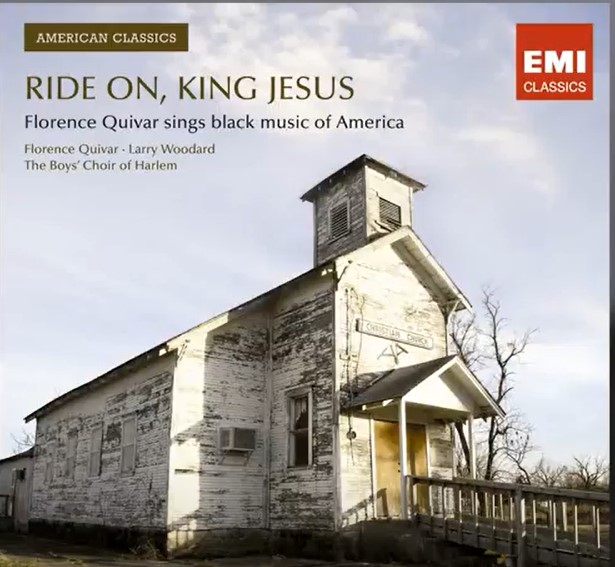
Sit Down, Servant · Florence Quivar · Larry Woodard · The Boys Choir Of Harlem · Walter Turnbull · Joseph Joubert
Ride On, King Jesus
℗ 1990 Angel Records
Released on: 1990-01-01
Associated Performer, Mezzo- Soprano: Florence Quivar
Associated Performer, Piano: Larry Woodard
Choir: The Boys Choir Of Harlem
Conductor: Walter Turnbull
Associated Performer, Piano: Joseph Joubert
Composer Lyricist: Traditional
Selection source: 4. Sit Down Servant
3. Serenity
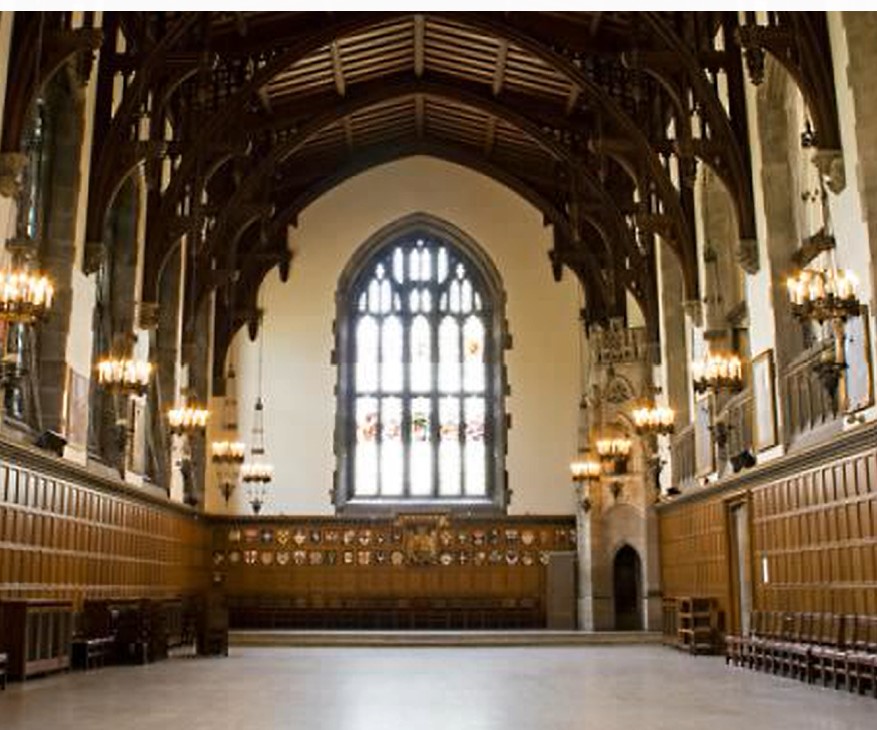
American composer Charles Ives “ Serenity”
The Hart House Chorus performs its 2006 fall concert, A New England Retrospective. Performed on November 26, 2006 in the Great Hall at Hart House at the University of Toronto.
Selection source: 3. Serenity
2. WINCHESTER CATHEDRAL-DEAR LORD AND FATHER OF MANKIND

Dear Lord and Father of Mankind, John Greenleaf Whittier
SONGS OF PRAISE SPECIAL FROM WINCHESTER CATHEDRAL
August 13, 2012
Selection source: 2. WINCHESTER CATHEDRAL-DEAR LORD AND FATHER OF MANKIND
1. I Bind unto Myself Today (St. Patrick’s Breastplate)
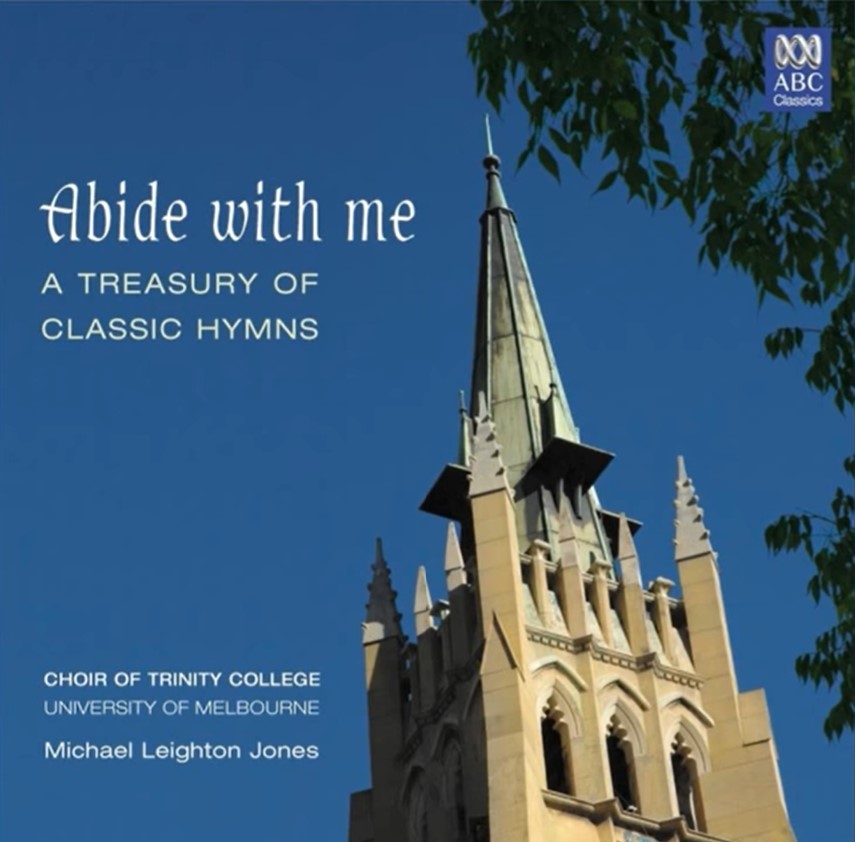
Traditional: I Bind Unto Myself Today · Choir Of Trinity College, University Of Melbourne · Michael Leighton Jones · Jonathan Bradley
Abide With Me: A Treasury Of Classic Hymns
℗ 2006 Australian Broadcasting Corporation
Selection source: 1. I Bind unto Myself Today (St. Patrick’s Breastplate)